Mantle Volatiles and Heat Contributions to the Cu-Pb-Zn Mineralization in the Baoshan Deposit, South China: Constraints from He and Ar Isotopes
Abstract
1. Introduction
2. Geological Settings
3. Sampling and Analytical Methods
4. Results
5. Discussion
5.1. Post-Entrapment Modification of Fluid Inclusions
5.2. Sources of He, Ar, and S
5.3. Helium and Heat
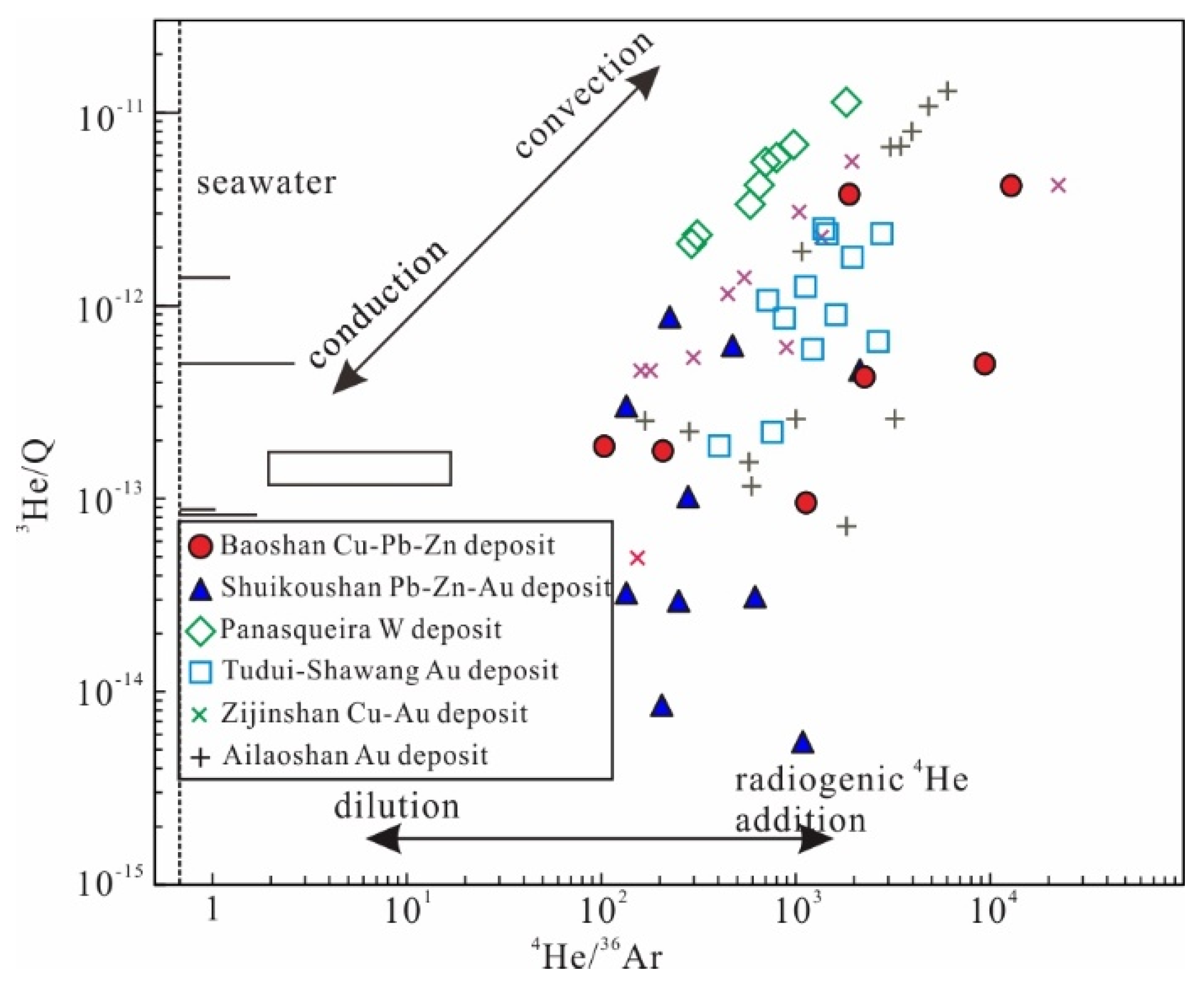
5.4. Implications for the Cu-Pb-Zn Mineralization
| Deposit | 3He/4He (Ra) | 40Ar/36Ar | References |
|---|---|---|---|
| Granite-related W-Sn deposits | |||
| Yaogangxian W deposit | 0.41–3.03 | 328–1191 | [26] |
| Furong Sn deposit | 0.13–2.95 | [13] | |
| Xintianling W deposit | 4.08 | 342 | [37] |
| Shizhuyuan W-Sn-Bi-Mo deposit | 0.06–1.66 | 293–1072 | [35] |
| Xitian W-Sn deposit | 1.15–4.43 | 288–325 | [92] |
| Xianghualing Sn deposit | 1.84 | 326 | [92] |
| Piaotang W-Sn deposit | 0.17–0.86 | 355–591 | [93] |
| Yaoling-Meiziwo W deposit | 0.0043–4.36 | 330–2953 | [36] |
| Dachang Sn deposit | 0.7–2.9 | 310–446 | [94,95] |
| Granite-related Cu-Pb-Zn deposits | |||
| Baoshan Cu-Pb-Zn deposit | 0.04–1.51 | 303–596 | This study |
| Shuikoushan Pb-Zn-Au deposit | 0.01–2.93 | 298–382 | [43] |
6. Conclusions
Author Contributions
Funding
Data Availability Statement
Acknowledgments
Conflicts of Interest
References
- Maruyama, S.; Isozaki, Y.; Kimura, G.; Terabayashi, M. Paleogeographic maps of the Japanese Islands: Plate tectonic synthesis from 750 Ma to the present. Isl. Arc 1997, 6, 121–142. [Google Scholar] [CrossRef]
- Wang, D.Z. The study of granitic rocks in South China: Looking back and forward. Geol. J. China Univ. 2004, 10, 305–314, (In Chinese with English Abstract). [Google Scholar]
- Zhou, X.M.; Sun, T.; Shen, W.; Shu, L.; Niu, Y. Petrogenesis of Mesozoic granitoids and volcanic rocks in South China: A response to tectonic evolution. Episodes 2006, 29, 26–33. [Google Scholar] [CrossRef] [PubMed]
- Hua, R.M.; Mao, J.W. A preliminary discussion on the Mesozoic metallogenic explosion in East China. Miner. Depos. 1999, 18, 300–308, (In Chinese with English Abstract). [Google Scholar]
- Mao, J.W.; Cheng, Y.B.; Chen, M.H.; Franco, P. Major types and time–space distribution of Mesozoic ore deposits in South China and their geodynamic settings. Miner. Depos. 2013, 48, 267–294. [Google Scholar] [CrossRef]
- Li, X.F.; Hu, R.Z.; Hua, R.M.; Ma, D.S.; Wu, L.Y.; Qi, Y.Q.; Peng, J.T. The Mesozoic syntexis type granite-related Cu-Pb-Zn mineralization in South China. Acta Petrol. Sin. 2013, 29, 4037–4050, (In Chinese with English Abstract). [Google Scholar]
- Hu, R.Z.; Chen, W.T.; Xu, D.R.; Zhou, M.F. Reviews and new metallogenic models of mineral deposits in South China: An introduction. J. Asian Earth Sci. 2017, 137, 1–8. [Google Scholar] [CrossRef]
- Ni, P.; Pan, J.Y.; Han, L.; Cui, J.M.; Gao, Y.; Fan, M.S.; Li, W.S.; Chi, Z.; Zhang, K.H.; Cheng, Z.L.; et al. Tungsten and tin deposits in South China: Temporal and spatial distribution, metallogenic models and prospecting directions. Ore Geol. Rev. 2023, 157, 105453. [Google Scholar] [CrossRef]
- Hua, R.M.; Chen, P.R.; Zhang, W.L.; Liu, X.D.; Lu, J.J.; Lin, J.F.; Yao, J.M.; Qi, H.W.; Zhang, Z.S.; Gu, S.Y. Metallogenic systems related to Mesozoic and Cenozoic granitoids in South China. Sci. China Ser. D 2003, 46, 816–829. [Google Scholar] [CrossRef]
- Xu, K.Q.; Hu, S.X.; Sun, M.Z.; Ye, J. On the two genetic series of granites in Southeastern China and their metallogenetic characteristics. Miner. Depos. 1982, 1, 1–14, (In Chinese with English Abstract). [Google Scholar]
- Xu, K.Q.; Hu, S.X.; Sun, M.Z.; Zhang, J.R.; Ye, J. On the genetic series of granites, as exemplified by the Mesozoic granites of South China. Acta Petrol. Sin. 1983, 57, 97–106, (In Chinese with English Abstract). [Google Scholar]
- Peng, J.T.; Zhou, M.F.; Hu, R.Z.; Shen, N.P.; Yuan, S.D.; Bi, X.W.; Du, A.D.; Qu, W.J. Precise molybdenite Re–Os and mica Ar–Ar dating of the Mesozoic Yaogangxian tungsten deposit, central Nanling district, South China. Mineral. Depos. 2006, 41, 661–669. [Google Scholar] [CrossRef]
- Li, Z.L.; Hu, R.Z.; Yang, J.H.; Peng, J.S.; Li, X.M.; Bi, X.W. He, Pb and S isotopic constraints on the relationship between the A-type Qitianling granite and the Furong tin deposit, Hunan Province, China. Lithos 2007, 97, 161–173. [Google Scholar] [CrossRef]
- Zhou, M.F.; Gao, J.F.; Zhao, Z.; Zhao, W.W. Introduction to the special issue of Mesozoic W-Sn deposits in South China. Ore Geol. Rev. 2018, 101, 432–436. [Google Scholar] [CrossRef]
- Mao, J.W.; Xie, G.Q.; Guo, C.L.; Yuan, S.D.; Cheng, Y.B.; Chen, Y.C. Spatial-temporal distribution of Mesozoic ore deposits in South China and their metallogenic settings. Geol. J. China Univ. 2008, 14, 510–526, (In Chinese with English Abstract). [Google Scholar]
- Wang, Y.J.; Fan, W.M.; Guo, F.; Li, H.M.; Liang, X.Q. U-Pb dating of early Mesozoic granodioritic intrusions in southeastern Hunan Province, South China and its petrogenetic implications. Sci. China Ser. D 2002, 45, 280–288. [Google Scholar] [CrossRef]
- Wang, Y.J.; Fan, W.M.; Guo, F. Geochemistry of early Mesozoic potassium-rich diorites-granodiorites in southeastern Hunan Province, South China: Petrogenesis and tectonic implications. Geochem. J. Janpan 2003, 37, 427–448. [Google Scholar] [CrossRef]
- Lu, Y.F.; Ma, L.Y.; Qu, W.J.; Mei, Y.P.; Chen, X.Q. U-Pb and Re-Os isotope geochronology of Baoshan Cu-Mo polymetallic ore deposit in Hunan Province. Acta Petrol. Sin. 2006, 22, 2483–2492, (In Chinese with English Abstract). [Google Scholar]
- Ma, L.Y.; Lu, Y.F.; Mei, Y.P.; Chen, X.Q. Zircon SHRIMP U-Pb dating of granodiorite from Shuikoushan ore-field, Hunan Province and its geological significance. Acta Petrol. Sin. 2006, 22, 2475–2482, (In Chinese with English Abstract). [Google Scholar]
- Huang, J.C.; Peng, J.T.; Yang, J.H.; Zhang, B.L.; Xu, C.X. Precise zircon U–Pb and molybdenite Re–Os dating of the Shuikoushan granodiorite-related Pb–Zn mineralization, southern Hunan, South China. Ore Geol. Rev. 2015, 71, 305–317. [Google Scholar] [CrossRef]
- Huang, J.C.; Peng, J.T.; Yang, J.H.; Xu, C.X.; Hu, S.B. Geochemistry and genesis of the Shuikoushan granodiorite, southern Hunan, South China. Geochimica 2015, 44, 131–144, (In Chinese with English Abstract). [Google Scholar]
- Zhao, P.L.; Yuan, S.D.; Mao, J.W.; Santosh, M.; Li, C.; Hou, K.J. Geochronological and petrogeochemical constraints on the skarn deposits in Tongshanling ore district, southern Hunan Province: Implications for Jurassic Cu and W metallogenic events in South China. Ore Geol. Rev. 2016, 78, 120–137. [Google Scholar] [CrossRef]
- Zhao, P.L.; Yuan, S.D.; Mao, J.W.; Santosh, M.; Zhang, D.L. Zircon U–Pb and Hf–O isotopes trace the architecture of polymetallic deposits: A case study of the Jurassic ore-forming porphyries in the Qin–Hang metallogenic belt, China. Lithos 2017, 292–293, 132–145. [Google Scholar] [CrossRef]
- Simmons, S.F.; Sawkins, F.; Schlutter, D. Mantle-derived helium in two Peruvian hydrothermal ore deposits. Nature 1987, 329, 429–432. [Google Scholar] [CrossRef]
- Stuart, F.; Burnard, P.; Taylor, R.P.; Turner, G. Resolving mantle and crustal contributions to ancient hydrothermal fluids: He-Ar isotopes in fluid inclusions from Dae Hwa W-Mo mineralisation, South Korea. Geochim. Cosmochim. Acta 1995, 59, 4663–4673. [Google Scholar] [CrossRef]
- Hu, R.Z.; Bi, X.W.; Jiang, G.H.; Chen, H.W.; Peng, J.T.; Qi, Y.Q.; Wu, L.Y.; Wei, W.F. Mantle-derived noble gases in ore-forming fluids of the granite-related Yaogangxian tungsten deposit, Southeastern China. Mineral. Depos. 2012, 47, 623–632. [Google Scholar] [CrossRef]
- Burnard, P.G.; Hu, R.Z.; Turner, G.; Bi, X.W. Mantle, crustal and atmospheric noble gases in Ailaoshan gold deposits, Yunnan Province, China. Geochim. Cosmochim. Acta 1999, 63, 1595–1604. [Google Scholar] [CrossRef]
- Kendrick, M.A.; Burgess, R.; Pattrick, R.; Turner, G. Fluid inclusion noble gas and halogen evidence on the origin of Cu-Porphyry mineralising fluids. Geochim. Cosmochim. Acta 2001, 65, 2651–2668. [Google Scholar] [CrossRef]
- Burnard, P.G.; Polya, D.A. Importance of mantle derived fluids during granite associated hydrothermal circulation: He and Ar isotopes of ore minerals from Panasqueira. Geochim. Cosmochim. Acta 2004, 68, 1607–1615. [Google Scholar] [CrossRef]
- Turner, G.; Stuart, F. Helium/heat ratios and deposition temperatures of sulphides from the ocean floor. Nature 1992, 357, 581–583. [Google Scholar] [CrossRef]
- Stuart, F.; Turner, G.; Duckworth, R.; Fallick, A. Helium isotopes as tracers of trapped hydrothermal fluids in ocean-floor sulfides. Geology 1994, 22, 823–826. [Google Scholar] [CrossRef]
- Wu, L.Y.; Hu, R.Z.; Li, X.F.; Stuart, F.M.; Jiang, G.H.; Qi, Y.Q.; Zhu, J.J. Mantle volatiles and heat contributions in high sulfidation epithermal deposit from the Zijinshan Cu-Au-Mo-Ag orefield, Fujian Province, China: Evidence from He and Ar isotopes. Chem. Geol. 2017, 480, 58–65. [Google Scholar] [CrossRef]
- Graham, D.W. Noble Gas Isotope Geochemistry of Mid-Ocean Ridge and Ocean Island Basalts: Characterization of Mantle Source Reservoirs. Rev. Mineral. Geochem. 2002, 47, 247–317. [Google Scholar] [CrossRef]
- Li, Z.L.; Hu, R.Z.; Peng, J.T.; Bi, X.W.; Li, X.M. Helium Isotope Geochemistry of Ore-forming Fluids from Furong Tin Orefield in Hunan Province, China. Resour. Geol. 2006, 56, 9–15. [Google Scholar] [CrossRef]
- Wu, L.Y.; Hu, R.Z.; Peng, J.T.; Bi, X.W.; Jiang, G.H.; Chen, H.W.; Wang, Q.Y.; Liu, Y.Y. He and Ar isotopic compositions and genetic implications for the giant Shizhuyuan W–Sn–Bi–Mo deposit, Hunan Province, South China. Int. Geol. Rev. 2011, 53, 677–690. [Google Scholar] [CrossRef]
- Zhai, W.; Sun, X.M.; Wu, Y.S.; Sun, Y.Y.; Hua, R.M.; Ye, X.R. He-Ar isotope geochemistry of the Yaoling-Meiziwo tungsten deposit, North Guangdong Province: Constraints on Yanshanian crust-mantle interaction and metallogenesis in SE China. Chin. Sci. Bull. 2012, 57, 1150–1159. [Google Scholar] [CrossRef]
- Cai, M.H.; Han, F.B.; He, L.Q.; Liu, G.Q.; Chen, K.X.; Fu, J.M. He, Ar isotope characteristics and Rb-Sr dating of the Xintianling skarn scheelite deposit in Southern Hunan, China. Acta Geosci. Sin. 2008, 29, 167–173, (In Chinese with English Abstract). [Google Scholar]
- Cai, M.H.; Wang, X.B.; Keisuke, N.; Peng, Z.A.; Guo, T.F.; Liu, H.; Tan, Z.M. Noble gas isotopic characteristics of Hehuaping tin-polymetallic deposit, southern Hunan Province. Miner. Depos. 2012, 31, 1163–1170, (In Chinese with English Abstract). [Google Scholar]
- Cai, M.H.; Peng, Z.A.; Keisuke, N.; Wang, X.B.; Guo, T.F.; Liu, H. Isotopic characteristics of noble gases of the Fuchuan-Hezhou-Zhongshan W-Sn-polymetallic ore concentration area in Northeastern Guangxi and their geological significance. Acta Geosci. Sin. 2013, 34, 287–294, (In Chinese with English Abstract). [Google Scholar]
- Shan, Q.; Zeng, Q.S.; Li, J.K.; Lu, H.Z.; Hou, M.Z.; Yu, X.Y.; Wu, C.J. Diagenetic and metallogenic sources of Furong tin deposit, Qitianling: Constraints from Lu-Hf for zircon and He-Ar isotope for fluid inclusions. Acta Geol. Sin. 2014, 88, 704–715, (In Chinese with English Abstract). [Google Scholar]
- Wei, W.F.; Hu, R.Z.; Bi, X.W.; Jiang, G.H.; Yan, B.; Yin, R.S.; Yang, J.H. Mantle-derived and crustal He and Ar in the ore-forming fluids of the Xihuashan granite-associated tungsten ore deposit, South China. Ore Geol. Rev. 2019, 105, 605–615. [Google Scholar] [CrossRef]
- Wu, L.Y. Advances of noble gas isotope geochemistry application in the study of ore deposits. Acta Petrol. Sin. 2019, 3, 215–232, (In Chinese with English Abstract). [Google Scholar]
- Huang, J.C.; Peng, J.T.; Xie, T.X.; Yang, J.H. Relationship between Pb-Zn and Au mineralization in the Laoyachao deposit, South China: Constraints from geology and S-Pb-He-Ar isotopes. J. Asian Earth Sci. 2024, 270, 106190. [Google Scholar] [CrossRef]
- Mao, J.W.; Chen, M.H.; Yuan, S.D.; Guo, C.L. Geological characteristics of the Qin-Hang (or Shihang) metallogenic belt in South China and spatial-temporal distribution regularity of mineral deposits. Acta Geol. Sin. 2011, 85, 636–658, (In Chinese with English Abstract). [Google Scholar]
- Ding, T.; Ma, D.S.; Lu, J.J.; Zhang, R.Q.; Xie, Y.C. Sulfur and lead isotopic compositions of granitoids and fluid inclusions in Baoshan deposit, Hunan Province. Miner. Depos. 2016, 35, 663–676, (In Chinese with English Abstract). [Google Scholar]
- Zhu, X.Y.; Wang, J.B.; Wang, Y.L.; Cheng, X.Y.; Fu, Q.B. Sulfur and lead isotope constraints on ore formation of the Huangshaping W-Mo-Bi-Pb-Zn polymetallic ore deposit, Hunan Province, South China. Acta Petrol. Sin. 2012, 28, 3809–3822, (In Chinese with English Abstract). [Google Scholar]
- Bao, T.; Ye, L.; Yang, Y.L.; Li, Z.L. Characteristics of sulfur isotope geochemistry of Baoshan Cu-Mo-Pb-Zn-Ag polymetallic deposit, Hunan Province and its geological significance. Acta Mineral. Sin. 2014, 34, 261–266, (In Chinese with English Abstract). [Google Scholar]
- Xie, Y.C.; Lu, J.J.; Yang, P.; Ma, D.S.; Xu, Z.W.; Zhang, R.Q.; Cai, Y.; Ding, T. S, Pb, C and O isotopic characteristics and sources of metallogenic materials of Baoshan Pb-Zn deposit, southern Hunan Province. Miner. Depos. 2015, 34, 333–351, (In Chinese with English Abstract). [Google Scholar]
- Xuan, Y.S.; Yuan, S.D.; Mi, J.R.; Zhao, P.L.; Yuan, Y.B.; Zhang, D.L. Preliminary studies on the fluid inclusions and H-O isotopic geochemistry of the Baoshan copper polymetallic deposit, Hunan Province. Acta Petrol. Sin. 2017, 33, 873–886, (In Chinese with English Abstract). [Google Scholar]
- Ding, T.; Tan, T.T.; Wang, J.; Ma, D.S.; Lu, J.J.; Zhang, R.Q.; Liang, J.; Wu, B. Multiple sources for the Baoshan polymetallic Cu–Mo–Pb–Zn deposit, southern Hunan Province, China: Insights from in situ LA–MC–ICP–MS sulfur isotopic compositions. Ore Geol. Rev. 2022, 143, 104808. [Google Scholar] [CrossRef]
- Huang, J.C.; Peng, J.T. Rare earth element (REE) geochemistry of different colored fluorites from the Baoshan Cu–Pb–Zn deposit, Southern Hunan, South China. Acta Geochim. 2022, 41, 419–433. [Google Scholar] [CrossRef]
- Xie, Y.C.; Lu, J.J.; Ma, D.S.; Zhang, R.Q.; Gao, J.F.; Yao, Y. Origin of granodiorite porphyry and mafic microgranular enclave in the Baoshan Pb-Zn polymetallic deposit, southern Hunan Province: Zircon U-Pb chronological, geochemical and Sr-Nd-Hf isotopic constraints. Acta Petrol. Sin. 2013, 29, 4186–4214, (In Chinese with English Abstract). [Google Scholar]
- Mi, J.R.; Yuan, S.D.; Xuan, Y.S.; Zhang, D.L. Zircon U-Pb ages, Hf isotope and trace element characteristics of the granodiorite porphyry from the Baoshan-Dafang ore district, Hunan: Implications for regional metallogeny. Acta Geol. Sin. Engl. 2018, 34, 2548–2564, (In Chinese with English Abstract). [Google Scholar]
- Li, Z.X.; Li, X.H.; Zhou, H.W.; Kinny, P.D. Grenvillian continental collision in south China: New SHRIMP U-Pb zircon results and implications for the configuration of Rodinia. Geology 2002, 30, 163–166. [Google Scholar] [CrossRef]
- Zhou, M.F.; Yan, D.P.; Kennedy, A.K.; Li, Y.Q.; Ding, J. SHRIMP U-Pb zircon geochronological and geochemical evidence for Neoproterozoic arc-magmatism along the western margin of the Yangtze Block, South China. Earth Planet. Sci. Lett. 2002, 196, 51–67. [Google Scholar] [CrossRef]
- Yan, D.P.; Zhou, M.F.; Song, H.L.; Wang, X.W.; Malpas, J. Origin and tectonic significance of a Mesozoic multi-layer over-thrust system within the Yangtze Block (South China). Tectonophysics 2003, 361, 239–254. [Google Scholar] [CrossRef]
- Hu, R.Z.; Zhou, M.F. Multiple Mesozoic mineralization events in South China—An introduction to the thematic issue. Mineral. Depos. 2012, 47, 579–588. [Google Scholar] [CrossRef]
- Yuan, S.D.; Williams-Jones, A.E.; Mao, J.W.; Zhao, P.L.; Yan, C.; Zhang, D.L. The origin of the Zhangjialong tungsten deposit, South China: Implications for W-Sn mineralization in large granite batholiths. Econ. Geol. 2018, 113, 1193–1208. [Google Scholar] [CrossRef]
- Yuan, S.D.; Williams-Jones, A.E.; Romer, R.L.; Zhao, P.L.; Mao, J.W. Protolith-Related Thermal Controls on the Decoupling of Sn and W in Sn-W Metallogenic Provinces: Insights from the Nanling Region, China. Econ. Geol. 2019, 114, 1005–1012. [Google Scholar] [CrossRef]
- Li, W.S.; Ni, P.; Pan, J.Y.; Albanese, S.; De Vivo, B.; Esposito, R.; Ding, J.Y. The genetic association between vein and skarn type tungsten mineralization in the Yaogangxian tungsten deposit, South China: Constraints from LA-ICP-MS analysis of individual fluid inclusion. Ore Geol. Rev. 2023, 159, 105544. [Google Scholar] [CrossRef]
- Lu, H.Z.; Liu, Y.; Wang, C.; Xu, Y.; Li, H. Mineralization and fluid inclusion study of the Shizhuyuan W-Sn-Bi-Mo-F skarn deposit, Hunan Province, China. Econ. Geol. 2003, 98, 955–974. [Google Scholar] [CrossRef]
- Li, X.H.; Liu, D.; Sun, M.; Li, W.X.; Liang, X.R.; Liu, Y. Precise Sm–Nd and U–Pb isotopic dating of the supergiant Shizhuyuan polymetallic deposit and its host granite, SE China. Geol. Mag. 2004, 141, 225–231. [Google Scholar] [CrossRef]
- Xing, L.Z.; Peng, J.T.; Lv, Y.J.; Tang, Y.W.; Gao, J.F. Vesuvianite: A potential U-Pb geochronometer for skarn mineralization—A case study of tungsten and tin deposits in South China. Chem. Geol. 2022, 607, 121017. [Google Scholar] [CrossRef]
- Yuan, S.D.; Peng, J.T.; Hao, S.; Li, H.M.; Geng, J.Z.; Zhang, D.L. In situ LA-MC-ICP-MS and ID-TIMS U–Pb geochronology of cassiterite in the giant Furong tin deposit, Hunan Province, South China: New constraints on the timing of tin–polymetallic mineralization. Ore Geol. Rev. 2011, 43, 235–242. [Google Scholar] [CrossRef]
- Chen, S.C.; Yu, J.J.; Bi, M.F.; Li, H.M.; Lehmann, B. Cassiterite U–Pb, mica 40Ar–39Ar dating and cassiterite trace-element composition of the Furong tin deposit in the Nanling Range, South China. Ore Geol. Rev. 2022, 143, 104775. [Google Scholar] [CrossRef]
- Hu, A.X.; Peng, J.T.; Suo, M.Y. The first discovery of axinite in the Furong tin deposit, southern Hunan: An important boron-bearing mineral and its implications for tin mineralization. Acta Petrol. Sin. 2023, 39, 1730–1742, (In Chinese with English Abstract). [Google Scholar] [CrossRef]
- Yuan, S.D.; Peng, J.T.; Hu, R.Z.; Li, H.M.; Shen, N.P.; Zhang, D.L. A precise U–Pb age on cassiterite from the Xianghualing tin-polymetallic deposit (Hunan, South China). Mineral. Depos. 2008, 43, 375–382. [Google Scholar] [CrossRef]
- Wu, Q.; Feng, C.Y.; Mao, J.W.; Santosh, M.; Dick, J.M.; Yu, M.; Li, B. Robust monazite U-Pb and molybdenite Re-Os ages reveal the magmatic and metallogenic history of a highly evolved granitic system in the Xianghualing deposit, South China. Ore Geol. Rev. 2022, 140, 104602. [Google Scholar] [CrossRef]
- Wang, K.X.; Zhai, D.G.; Williams-Jones, A.E.; Li, D.F.; Liu, J.J. Discrete late Jurassic Sn mineralizing events in the Xianghualing Ore District, South China: Constraints from cassiterite and garnet U-Pb geochronology. Am. Miner. 2023, 108, 1384–1398. [Google Scholar] [CrossRef]
- Li, N.Q.; Peng, C. Shuikoushan Lead-Zinc-Gold-Silver Orefield, Hunan, China; Seismological Press: Beijing, China, 1996; pp. 1–103. (In Chinese) [Google Scholar]
- Ding, T.; Tan, T.T.; Wang, J.; Ma, D.S.; Lu, J.J.; Zhang, R.Q.; Liang, J. Trace-element composition of pyrite in the Baoshan Cu–Mo–Pb–Zn deposit, southern Hunan Province, China: Insights into the ore genesis. Ore Geol. Rev. 2022, 147, 104989. [Google Scholar] [CrossRef]
- Zhu, D.P.; Li, H.; Tamehe, L.S.; Jiang, W.C.; Wang, C.; Wu, K.Y. Two-stage Cu-Pb-Zn mineralization of the Baoshan deposit in southern Hunan, South China: Constraints from zircon and pyrite geochronology and geochemistry. J. Geochem. Explor. 2022, 241, 107070. [Google Scholar] [CrossRef]
- Liu, B.; Kong, H.; Wu, Q.H.; Chen, S.F.; Li, H.; Xi, X.S.; Wu, J.H.; Jiang, H. Origin and evolution of W mineralization in the Tongshanling Cu–polymetallic ore field, South China: Constraints from scheelite microstructure, geochemistry, and Nd–O isotope evidence. Ore Geol. Rev. 2022, 143, 104764. [Google Scholar] [CrossRef]
- Yin, J.P. Metallogenic tectonics analysis about Baoshan Pb-Zn-Ag polymetallic deposit, Hunan, China. Geotecton. Metallog. 1998, S1, 57–61, (In Chinese with English Abstract). [Google Scholar]
- Kong, H.; Quan, T.J.; Zhong, J.L.; Chen, Z.F.; Wang, G.; Guo, B.Y.; Zhao, Z.Q. Geochemical characteristics of lamprophyre and its geological significance in Baoshan deposit, Hunan province, China. Chin. J. Nonferr. Met. 2013, 23, 2671–2682, (In Chinese with English Abstract). [Google Scholar]
- Yang, G.G.; Chen, Z.Q. Alteration of wallrocks and the mineralization zoning features in Baoshan copper-molybdenum-lead-zinc-silver mineralization field. Miner. Resour. Geol. 1998, 12, 96–100, (In Chinese with English Abstract). [Google Scholar]
- Tang, C.Y. Structural controlling characteristics of mineralization in Baoshan polymetallic ore field, Hunan Province. Miner. Resour. Geol. 2005, 19, 43–47, (In Chinese with English Abstract). [Google Scholar]
- Yang, Z.; Song, W.R.; Wen, H.J.; Zhang, Y.X.; Fan, Y.F.; Wang, F.; Li, Q.K.; Yang, T.; Zhou, Z.B.; Liao, S.L.; et al. Zinc, cadmium and sulphur isotopic compositions reveal biological activity during formation of a volcanic-hosted massive sulphide deposit. Gondwana Res. 2022, 101, 103–113. [Google Scholar] [CrossRef]
- Hu, R.Z.; Wei, W.F.; Bi, X.W.; Peng, J.T.; Qi, Y.Q.; Wu, L.Y.; Chen, Y.W. Molybdenite Re-Os and muscovite 40Ar/39Ar dating of the Xihuashan tungsten deposit, central Nanling district, South China. Lithos 2012, 150, 111–118. [Google Scholar] [CrossRef]
- Foeken, J.P.T.; Day, S.; Stuart, F.M. Cosmogenic 3He exposure dating of the Quaternary basalts from Fogo, Cape Verdes: Implications for rift zone and magmatic reorganisation. Quat. Geochronol. 2009, 4, 37–49. [Google Scholar] [CrossRef]
- York, D.; Masliwec, A.; Kuybida, P.; Hanes, J.A.; Hall, C.M.; Kenyon, W.J.; Spooner, E.T.C.; Scott, S.D. 40Ar/39 Ar dating of pyrite. Nature 1982, 300, 52. [Google Scholar] [CrossRef]
- Turner, G.; Burnard, P.; Ford, J.L.; Gilmour, J.D.; Lyon, I.C.; Stuart, F.M.; Gruszczynski, M.; Halliday, A. Tracing Fluid Sources and Interactions [and Discussion]. Philos. Trans. R. Soc. A 1993, 344, 127–140. [Google Scholar] [CrossRef]
- Yao, J.M.; Hua, R.M.; Lin, J.F. REE, Pb-S isotope geochemistry, and Rb-Sr isochron age of pyrites in the Baoshan deposit, South Hunan Province, China. Acta Petrol. Sin. 2006, 80, 1045–1054, (In Chinese with English Abstract). [Google Scholar]
- Baker, E.T.; Lupton, J.E. Changes in submarine hydrothermal 3He/heat ratios as an indicator of magmatic/tectonic activity. Nature 1990, 346, 556–558. [Google Scholar] [CrossRef]
- Lupton, J.E.; Baker, E.T.; Massoth, G.J.; Thomson, R.E.; Burd, B.J.; Butterfield, D.A.; Embley, R.W.; Cannon, G.A. Variations in water-column 3He/heat ratios associated with the 1993 CoAxial event, Juan de Fuca Ridge. Geophys. Res. Lett. 1995, 22, 155–158. [Google Scholar] [CrossRef]
- Jean-Baptiste, P.; Bougault, H.; Vangriesheim, A.; Charlou, J.L.; Radford-Knoery, J.; Fouquet, Y.; Needham, D.; German, C. Mantle 3He in hydrothermal vents and plume of the Lucky Strike site (MAR 37°17′ N) and associated geothermal heat flux. Earth Planet. Sci. Lett. 1998, 157, 69–77. [Google Scholar] [CrossRef]
- Liu, X.Y.; Tan, J.; He, H.Y.; Gan, J.R. Origin of the Tudui–Shawang gold deposit, Jiaodong Peninsula, north China Craton: Constraints from fluid inclusion and H-O-He-Ar-S-Pb isotopic compositions. Ore Geol. Rev. 2021, 133, 104125. [Google Scholar] [CrossRef]
- Hu, R.; Bi, X.; Truner, G. He and Ar isotope geochemistry of ore-forming fluid in Ailaoshan gold metallogenic belt. Sci. China (Ser. D) 1999, 29, 321–330. [Google Scholar]
- Li, H.; Kong, H.; Zhou, Z.K.; Wu, Q.H.; Xi, X.S.; Gabo-Ratio, J.A.S. Ore-forming material sources of the Jurassic Cu–Pb–Zn mineralization in the Qin–Hang ore belt, South China: Constraints from S–Pb isotopes. Geochemistry 2019, 79, 280–306. [Google Scholar] [CrossRef]
- Tan, J.; Wei, J.H.; He, H.Y.; Su, F.; Li, Y.J.; Fu, L.B.; Zhao, S.Q.; Xiao, G.L.; Zhang, F.; Xu, J.F.; et al. Noble gases in pyrites from the Guocheng-Liaoshang gold belt in the Jiaodong province: Evidence for a mantle source of gold. Chem. Geol. 2018, 480, 105–115. [Google Scholar] [CrossRef]
- Zhou, Z.H.; Mao, J.W.; Stuart, F.M.; Chen, X.K.; Wilde, S.A.; Ouyang, H.G.; Gao, X.; Zhao, J.Q. The role of mantle melting in granite-associated hydrothermal systems: He–Ar isotopes in fluids responsible for Sn–Ag–Pb–Zn mineralization in northeast China. Miner. Depos. 2023, 58, 1421–1443. [Google Scholar] [CrossRef]
- Liu, Y.H.; Fu, J.M.; Long, B.L.; Wei, J.Q.; Liu, G.Q.; Yang, X.J.; Yang, Y.Q. He and Ar isotopic components of main tin deposits from Central Nanling Region and its signification. J. Jilin Univ. (Earth Sci.) 2006, 36, 774–786, (In Chinese with English Abstract). [Google Scholar]
- Wang, X.D.; Ni, P.; Jiang, S.Y.; Zhao, K.D.; Wang, T.M. Origin of ore-forming fluid in the Piaotang tungsten deposit in Jiangxi Province: Evidence from Helium and argon isotopes. Chin. Sci. Bull. 2009, 54, 628–634. [Google Scholar] [CrossRef]
- Zhao, K.D.; Jiang, S.Y.; Xiao, H.Q.; Ni, P. Origin of ore-forming fluids of the Dachang Sn-polymetallic ore deposit: Evidence from helium isotopes. Chin. Sci. Bull. 2002, 47, 1041–1045. [Google Scholar] [CrossRef]
- Zhao, K.D.; Jiang, S.Y.; Ni, P.; Ling, H.F.; Jiang, Y.H. Sulfur, lead and helium isotopic compositions of sulfide minerals from the Dachang Sn-polymetallic ore district in South China: Implication for ore genesis. Mineral. Petrol. 2007, 89, 251–273. [Google Scholar] [CrossRef]
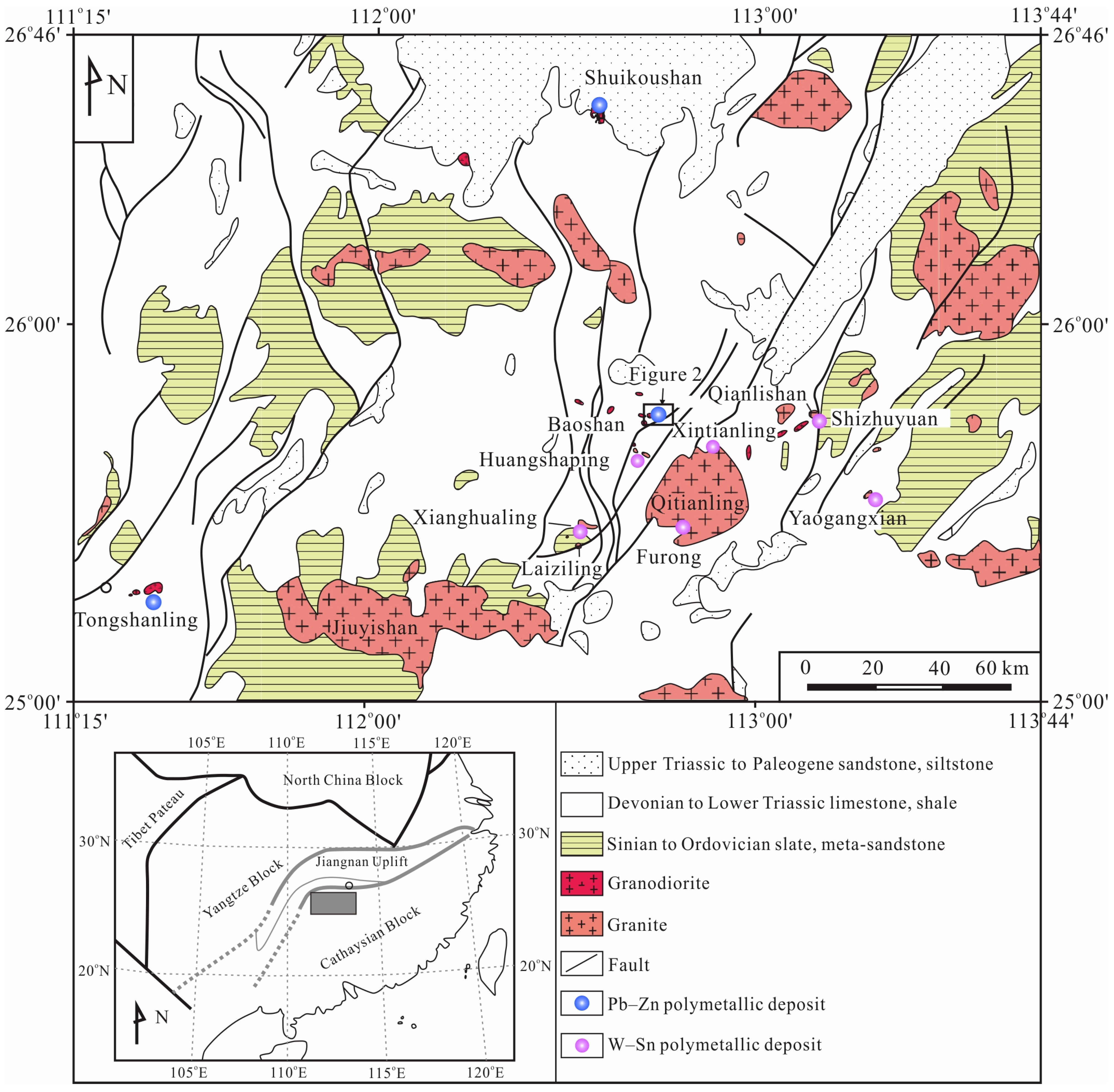
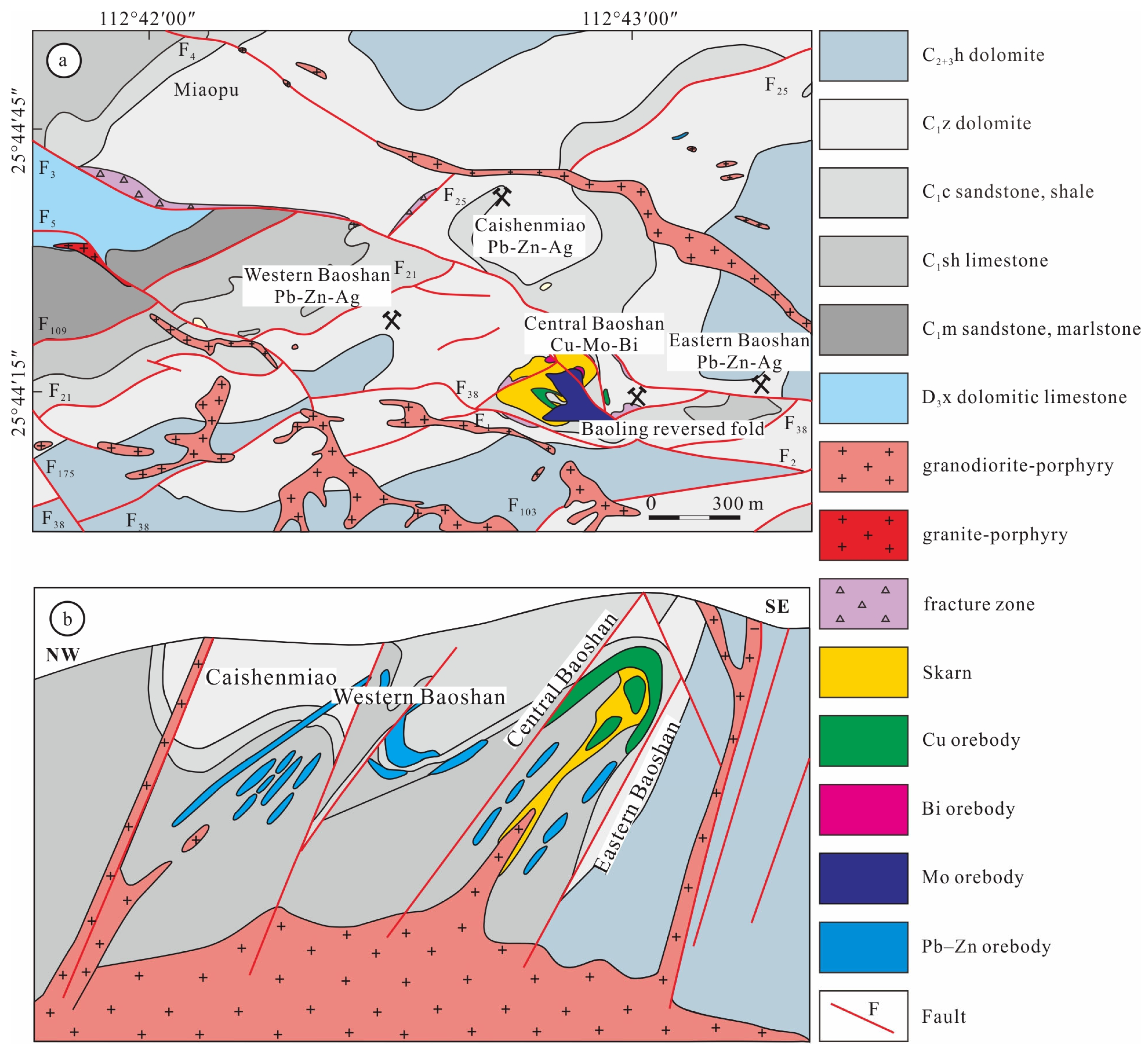
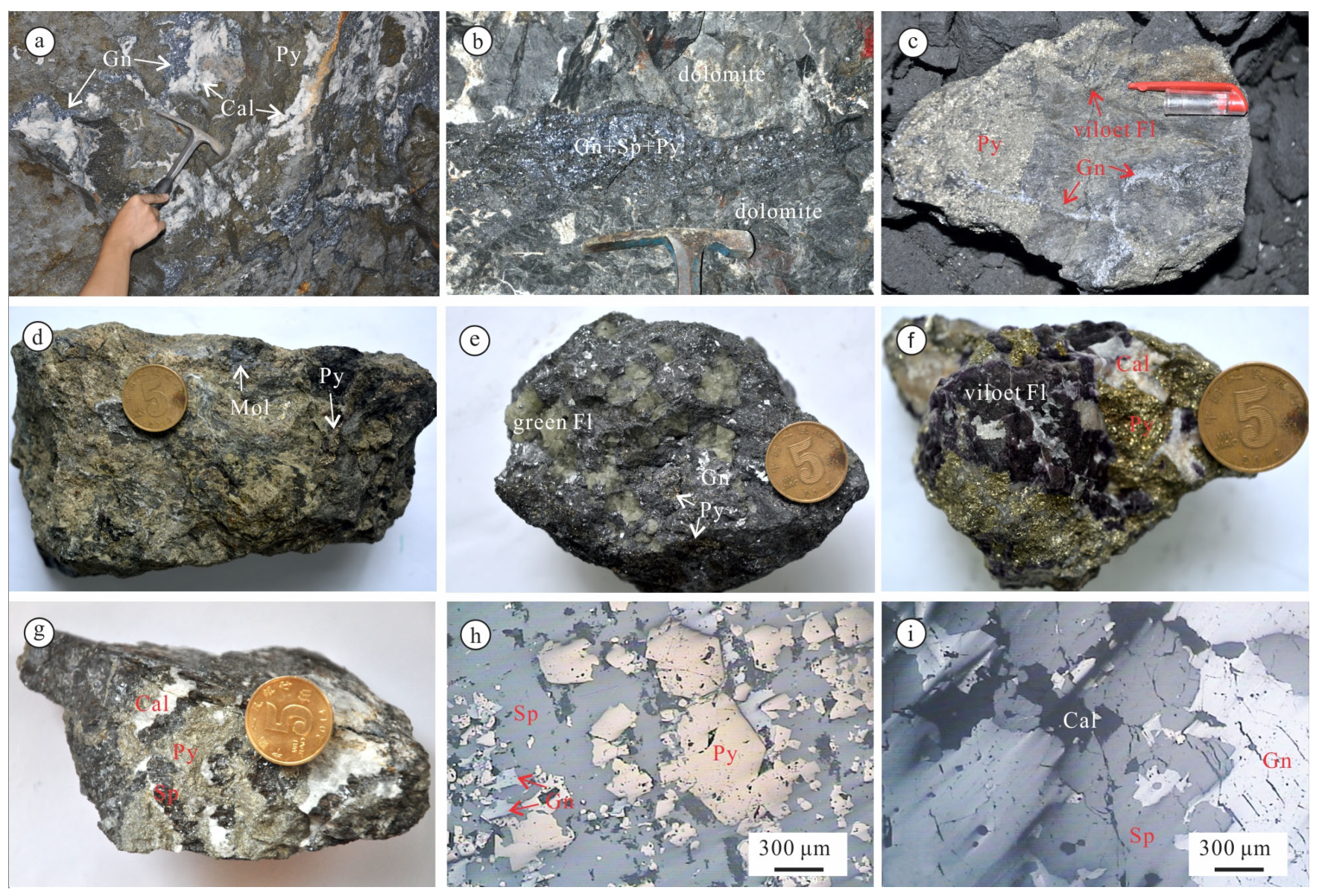
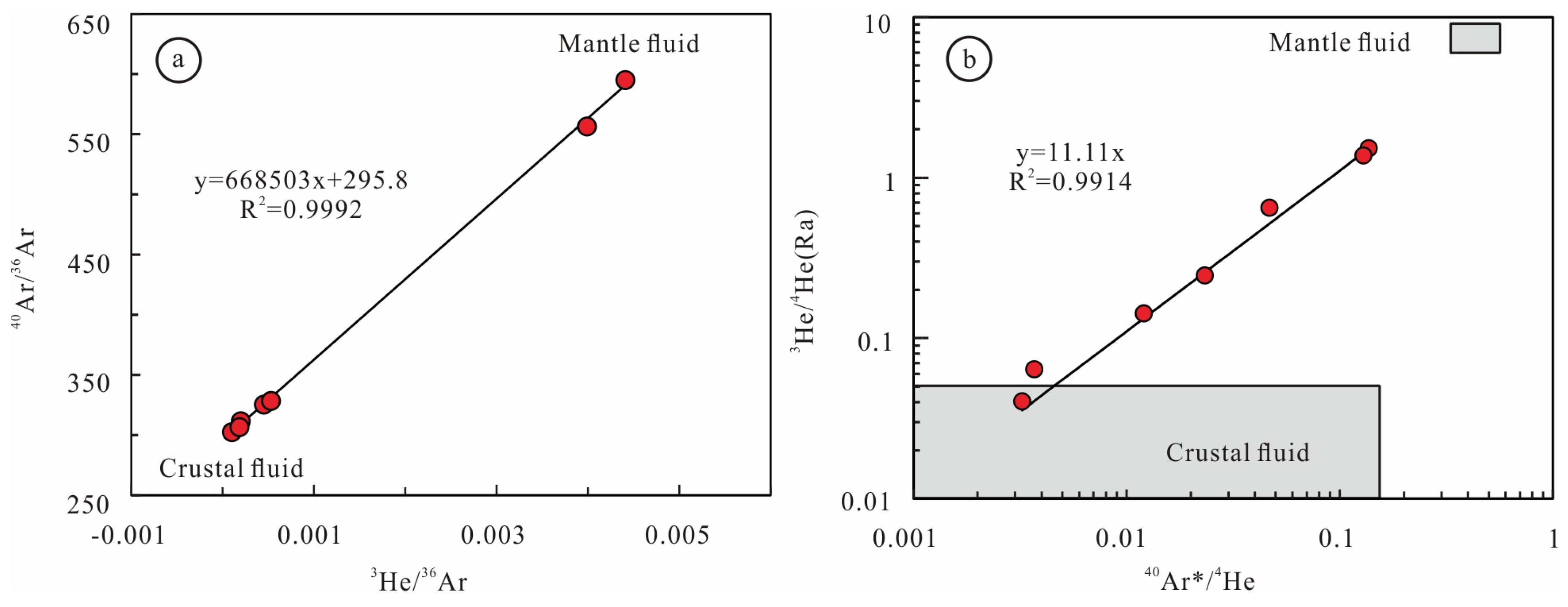


| Sample No. | Minerals | Sections | Sample Type | Mineralogical Characteristics |
|---|---|---|---|---|
| BS-7 | Sp | −190 m | Pb-Zn ores | Massive structure, fine-grained pyrite accompanied by brownish sphalerite and calcite. |
| BS-11 | Py | −190 m | Pyrite ores | Massive structure, abundant cubic pyrite accompanied by calcite and violet fluorite in the skarn. |
| BS-12 | Sp | −190 m | Pb-Zn ores | Massive structure, abundant coarse-grained brownish sphalerite with minor galena and fine-grained pyrite. |
| BS-13 | Py | −150 m | Pyrite ores | Massive structure, abundant coarse-grained and cubic pyrite with minor calcite. |
| BS-15 | Py | −150 m | Pyrite ores | Massive structure, abundant coarse-grained and cubic pyrite with minor calcite. |
| BS-18 | Py | −150 m | Pyrite ores | Massive structure, fine-grained pyrite accompanied by violet fluorite and calcite, also cut by veined calcite. |
| BS-25 | Py | −150 m | Pb-Zn ores | Massive structure, fine-grained pyrite with fine-grained sphalerite. |
| Sample | Mineral | Weight (g) 1 | 4He (10−7 cm3 STP) | 40Ar (10−7 cm3 STP) | 3He/4He (Ra) | 40Ar/36Ar | 3He/36Ar (10−5) | 40Ar*/4He (10−3) | 4He (cm3 STP g−1) | 40Ar (cm3 STP g−1) | F4He 2 | 40Ar* % 3 | Hemantle (%) | 3He/Q (10−12 cm3 STP J−1) 4 | δ34S (‰) |
|---|---|---|---|---|---|---|---|---|---|---|---|---|---|---|---|
| BS-7 | Sp | 0.24 | 2.04 ± 0.04 | 3.02 ± 0.05 | 0.65 ± 0.02 | 308 ± 7 | 18.71 ± 0.60 | 46.5 ± 0.68 | 8.61 × 10−6 | 1.28 × 10−6 | 1256 | 4.1 | 10.6 | 0.217 | 4.37 |
| BS-11 | Py | 0.20 | 8.08 ± 0.17 | 0.37 ± 0.01 | 0.25 ± 0.01 | 596 ± 34 | 440.41 ± 26.9 | 23.0 ± 0.07 | 3.95 × 10−5 | 1.83 × 10−7 | 77910 | 50.4 | 3.9 | 5.10 | 5.02 |
| BS-12 | Sp | 0.16 | 17.08 ± 0.36 | 4.55 ± 0.07 | 0.06 ± 0.01 | 303 ± 7 | 10.09 ± 0.38 | 3.6 ± 1.57 | 1.07 × 10−4 | 2.85 × 10−6 | 6861 | 2.4 | 0.9 | 0.117 | 2.30 |
| BS-13 | Py | 0.22 | 59.20 ± 1.26 | 2.06 ± 0.03 | 0.04 ± 0.01 | 329 ± 7 | 52.79 ± 1.79 | 3.2 ± 0.23 | 2.73 × 10−4 | 9.51 × 10−7 | 56979 | 10.1 | 0.5 | 0.612 | 2.89 |
| BS-15 | Py | 0.28 | 17.80 ± 0.38 | 2.55 ± 0.04 | 0.14 ± 0.01 | 326 ± 7 | 45.06 ± 1.44 | 11.9 ± 0.25 | 6.40 × 10−5 | 9.18 × 10−7 | 13712 | 9.3 | 2.2 | 0.522 | 2.56 |
| BS-18 | Py | 0.21 | 4.51 ± 0.10 | 1.32 ± 0.02 | 1.51 ± 0.05 | 557 ± 14 | 398.89 ± 12.0 | 136.0 ± 0.05 | 2.19 × 10−5 | 6.43 × 10−7 | 11465 | 46.9 | 25.1 | 4.62 | 5.21 |
| BS-25 | Py | 0.18 | 1.28 ± 0.03 | 3.87 ± 0.06 | 1.37 ± 0.04 | 312 ± 7 | 19.75 ± 0.57 | 128.2 ± 0.50 | 7.04 × 10−6 | 2.12 × 10−6 | 625 | 5.2 | 22.8 | 0.229 | 3.48 |
Disclaimer/Publisher’s Note: The statements, opinions and data contained in all publications are solely those of the individual author(s) and contributor(s) and not of MDPI and/or the editor(s). MDPI and/or the editor(s) disclaim responsibility for any injury to people or property resulting from any ideas, methods, instructions or products referred to in the content. |
© 2024 by the authors. Licensee MDPI, Basel, Switzerland. This article is an open access article distributed under the terms and conditions of the Creative Commons Attribution (CC BY) license (https://creativecommons.org/licenses/by/4.0/).
Share and Cite
Huang, J.; Peng, J.; Xie, T. Mantle Volatiles and Heat Contributions to the Cu-Pb-Zn Mineralization in the Baoshan Deposit, South China: Constraints from He and Ar Isotopes. Minerals 2024, 14, 839. https://doi.org/10.3390/min14080839
Huang J, Peng J, Xie T. Mantle Volatiles and Heat Contributions to the Cu-Pb-Zn Mineralization in the Baoshan Deposit, South China: Constraints from He and Ar Isotopes. Minerals. 2024; 14(8):839. https://doi.org/10.3390/min14080839
Chicago/Turabian StyleHuang, Jinchuan, Jiantang Peng, and Tengxiang Xie. 2024. "Mantle Volatiles and Heat Contributions to the Cu-Pb-Zn Mineralization in the Baoshan Deposit, South China: Constraints from He and Ar Isotopes" Minerals 14, no. 8: 839. https://doi.org/10.3390/min14080839
APA StyleHuang, J., Peng, J., & Xie, T. (2024). Mantle Volatiles and Heat Contributions to the Cu-Pb-Zn Mineralization in the Baoshan Deposit, South China: Constraints from He and Ar Isotopes. Minerals, 14(8), 839. https://doi.org/10.3390/min14080839





